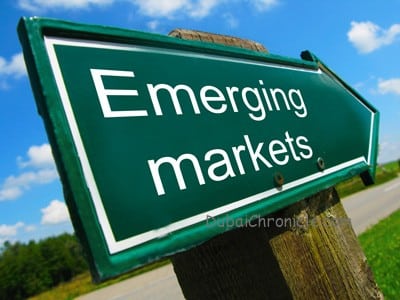
Emerging markets have been the darlings of global investors for most of the last decade. Even the most conservative investors, such as pension funds and sovereign wealth funds have increased their allocations to emerging markets assets.
However, recently the environment for capital flows to emerging economies has deteriorated sharply. Slowing growth and policy missteps have triggered deep sell-offs in emerging economies’ currency, bond, and equity markets. Signs that the US Federal Reserve will start tightening monetary policy by scaling back its “quantitative easing” (QE, or open-ended purchases of long-term assets) add to global investors concerns.
Some financial analysts claim that we are witnessing the collapse of yet another economic bubble.
Capital flows to emerging economies surged from 2002 to 2007, collapsed briefly during the 2008 global financial crisis, and then surged again from 2009 to 2011. In 2011, growing anxiety about a possible financial crisis in Europe interrupted these flows, but they rebounded in 2012. By the end of that year, flows of foreign direct investment (FDI), portfolio equity, and portfolio debt to emerging economies had reached record highs.
FDI flows, which are less volatile than other capital flows, remained by far the largest, accounting for nearly 60% of emerging markets’ total inflows in 2012. But, from 2009 to 2012, portfolio bond flows, which are sensitive to sudden shifts in investor sentiment, were the most rapidly growing component of inflows. Forthcoming research by the McKinsey Global Institute (MGI) estimates that emerging markets accounted for about 15% of all cross-border portfolio bond flows during this period – an all-time high.
According to economic theory, the major determinants of capital flows to emerging-market economies are real growth-rate differentials, interest-rate differentials, and global risk aversion. Faster growth and higher interest rates in emerging markets relative to those in developed economies encourage capital flows to the former, while an increase in global risk aversion – for example, during the eurozone crisis in 2011 – discourages them.
Research by the International Monetary Fund and a Fed working paper confirm that this theory fits the patterns of the last decade, although some changes have occurred since the 2008 financial crisis. The IMF finds that emerging markets’ net capital inflows have been above their long-term structural trend and more sensitive to interest-rate differentials since 2008. The Fed study finds that emerging economies’ total net capital inflows have been higher than expected in the post-crisis period, driven by larger-than-predicted net portfolio inflows (mainly bond flows). And, since the crisis, portfolio flows have been more sensitive to both interest-rate differentials and global risk aversion. The MGI also finds that, compared to pre-crisis trends, portfolio-debt inflows to emerging markets were larger than predicted between 2009 and 2012.
The recent decline in capital flows to emerging markets is also consistent with theory. For starters, the growth-rate differential favoring emerging markets has declined. China’s growth has fallen as it attempts to rein in excessive credit and bad debt. China’s slowdown and prolonged recession in parts of Europe have weakened demand in global commodity markets, depressing growth in commodity-exporting countries like Brazil, Russia, and South Africa.
Meanwhile, India’s growth rate has plunged as a result of faltering economic reforms and unsustainable budgetary choices: it now has record-high fiscal and current-account deficits. And political unrest has marred growth prospects in Turkey, Brazil, and South Africa.
Moreover, global risk aversion has spiked in response to Fed Chairman Ben Bernanke’s announcement of plans to “taper” QE. As the 2008 and 2011 experiences demonstrate, heightened risk aversion among global investors reduces capital flows to emerging markets, even when they are not the source of risk.
Finally, the interest-rate environment has changed. Despite repeated assertions by Fed officials that they are committed to near-zero short-term interest rates for the foreseeable future, hints of QE tapering have caused yields on ten-year US Treasury bonds to rise by 100 basis points from this year’s lows. Higher long-term interest rates in the US (and expectations of further hikes) are eating into the interest-rate differentials that attracted yield-hungry investors to emerging markets from 2009 to 2012.
The losses in emerging-market currencies and assets in recent months are a harsh reminder of an inconvenient truth: when the Fed tightens monetary policy to manage macroeconomic conditions in the US, there are large unintended spillover effects on capital flows to emerging markets. We saw this before in the events precipitating the financial crises that engulfed emerging markets in the late 1990’s.
Fortunately, many emerging economies are better prepared to weather the storm now than they were then. Their exchange rates are now flexible, they have built large foreign-currency reserves, and they have limited their foreign-currency debt. Moreover, their macroeconomic fundamentals are sound, and they have used macro- and micro-prudential tools to contain surges in capital inflows and minimize their destabilizing effects on asset prices and credit conditions.
But some countries are at risk, especially those with large current-account deficits, large foreign capital inflows relative to the size of their financial markets, and low foreign-exchange reserves. Among the most vulnerable are Turkey, South Africa, Brazil, India, and Indonesia – a group that Morgan Stanley researchers have dubbed the “Fragile Five.”
At the recent annual meeting of central bankers in Jackson Hole, Wyoming, IMF Managing Director Christine Lagarde expressed concern about slowing growth in emerging markets and urged them to pursue additional economic reforms. But she acknowledged that the inevitable exit from ultra-easy monetary policies in the US and other developed economies could trigger financial-market instability in emerging economies, and pledged IMF support, including on a precautionary or pre-emptive basis, to assist them.
Over the long term, owing to increasing populations, expanding middle classes, and rapid productivity gains, emerging-market economies that pursue sound policies will continue to grow much faster than developed economies. Once the market turbulence sparked by changes in US monetary policy subsides, they will once again become the darlings of global investors seeking returns from growth and diversification.





































